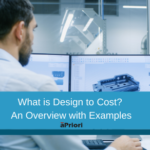
Conducting fact-based negotiations is an effective cost-reduction strategy when sourcing existing components. In this post, I will explain how to leverage digital manufacturing simulation software to conduct fact-based negotiations and provide real-world examples of manufacturers successfully using this strategy to obtain significant savings on current products.
What Do I Mean By Fact-Based Negotiations?
Digital manufacturing simulation software should provide you with a complete breakdown of information, such as material costs, labor costs, overhead costs, tooling investments, manufacturing process costs, etc., regarding a part so you can understand how the manufacturing cost is calculated.
During fact-based negotiations, this detailed component cost information guides discussions with your supplier, helping you focus on the biggest gaps between your data and theirs. This is a much more effective strategy than saying “your price is too high” or “I want a 10% reduction in costs.”
Identify Candidates for Immediate Negotiation
When looking for cost reduction opportunities among existing components, the first thing you have to do is narrow down your targets. Determine the scope of what you’re going to negotiate.
You can’t possibly negotiate everything that you buy.
In a previous article, “How to Conduct a Spend Analysis,” I explain the methodology in detail. In general, I recommend you target the items on which you spend the most money because that’s where the most savings opportunity is.
When you estimate the costs for the components that you have chosen as candidates for re-negotiation, I recommend you always double-check that you used the correct material and volumes, and added any secondary processes such as paint, polishing, heat treatments, etc.
You want to have the most accurate cost estimate possible when conducting these negotiations. Your overall number does not have to be exact. It just has to be a very good estimate for you to be able to negotiate.
Once you generate your estimates, you want to identify those parts where the estimated cost is significantly different (> 20%) from the price you are paying. Those are the parts you want to target for immediate negotiation.
Sometimes the difference between your estimate and the price you are paying is very big. The estimate may be perhaps half the price, or maybe even one fourth or one-fifth the price you are paying.
It is very tempting to say, “The estimate must be wrong; it can’t be that far off.”
It’s very easy to dismiss those estimates, but in fact, a big difference between your estimate and the price is an indication that something may be missing from the estimate or that something about the production process is not well understood.
It is worth investigating and I recommend you contact your supplier to find out where that difference is coming from.
CASE STUDY 1: SPEND ANALYSIS FINDS $250K ANNUAL SAVINGS OPPORTUNITY
As an example, I was working with a truck manufacturer, whose digital manufacturing simulation software was estimating a roof should cost about half what the company was actually paying.
When we contacted the supplier we had a very open conversation, and said, “We’ve been analyzing all of our high-spend parts, and generating some cost estimates. We estimated the cost for this roof, but it isn’t nearly as much as we’re paying, and we want to understand where the cost is going into it. Can you help us understand that?”
As it turns out, the painting process being specified, required the supplier to polish the roof. And because it was a concave part it couldn’t be put through a sander, because that might deform it. So, it had to be polished by hand, and that added a significant amount of cost.
In this case, it turned out the supplier was charging the right price – the part should cost as much as the supplier was charging – but now the customer knew the reason for it.
They went back to Engineering and reassessed what they could do about the paint spec because it was costing them about $250,000 per year extra.
That’s the type of actionable information you may find when you conduct fact-based negotiations with your suppliers. In other cases, you may find the supplier made a simple mistake, and you should be paying half or one-fourth of what you were paying. I’ll get to an example of that later.
Identify Standard Outliers
Next, you want to identify standard outliers, parts for which the price difference between what your digital manufacturing software estimates they should cost and what you pay is 25% to 40%. It is a significant enough difference to be called an outlier, so I again recommend the first step to take is to discuss with the supplier, where the cost might be going into it.
You may be missing a process, or there may be some other valid reason for the difference, but that is where the conversation starts, with “what is the cost breakdown?”
If you don’t find a reasonable resolution for the cost difference, then you need to investigate the details and begin the process of fact-based negotiation.
Get Detailed Cost Breakdowns For Outliers
Many companies ask for a detailed breakdown of the cost right from the start. If you have not, the first step is to obtain a breakdown of the cost.
Try to obtain breakdowns by material cost, manufacturing process costs, the main forming process, any extra machining costs, tooling costs, fixtures cost, assembly costs, any secondary processes such as painting, or inspections, any special inspections or heat treatment, and any transportation costs they may be charging you.
You want this detailed cost breakdown to compare to the estimate you generate with your digital manufacturing simulation software.
In many cases, suppliers will not be able to give you this entire breakdown, but they should, at least, be able to give you a breakdown of the material costs, principal manufacturing cost, tooling costs, painting and other secondary process costs, and transportation costs. Virtually all suppliers – and I’ve been on the supply side – will know these costs.
At the bare minimum, you should be able to get that breakdown from your digital manufacturing simulation software as well.
Identify Excessive Premiums
At this point, you have both a breakdown of cost by the supplier and a breakdown of cost.
You should ask the supplier which secondary processes they conduct in-house versus which ones they outsource because you want to find out how much of a premium you’re paying for those processes, which your supplier does not have the capability of doing themselves.
If they’re sending the part out for paint, or they’re sending the part out for heat treatment, how much of a premium, over and above what they’re paying, are you paying them? Is it as much as 50%, because if it is that high, you could easily negotiate that down to something more reasonable, like 20%
The same goes for transportation; if the supplier is paying for transportation for sending the parts to and from a sub-supplier, then yes, you need to pay for that because it’s part of the cost, but you shouldn’t be paying a high premium for that. You should be willing to give them some premium, but not an excessive premium.
Areas to Focus Cost Savings Investigations
Next, identify where your biggest differences are in the detailed cost breakdowns so you can focus your cost savings investigations.
• Is your biggest difference in material costs?
• Is it a case where the utilization is not as good as you had expected?
• Is the manufacturing process different?
• What are the setup costs? Does the supplier know what the setup costs are?
• What batch sizes are they running?
• What are their labor costs?
Identify the largest differences and then investigate the reasons behind them.
Examine the Manufacturing Process and Production Volume
It’s important to find out how the supplier is making the part, so you can compare it to what your digital manufacturing simulation software is suggesting. If they are different, find out the reasons why the discrepancy is there.
You may find out the supplier has limited capabilities, which may have been acceptable when your volumes were low, for example, but when your volumes go up, you may not be using the best supplier.
Or you may have a part, which you initially purchased one thousand parts per year, and it was okay to make it on a turret press at that volume. Now you’re buying fifteen thousand parts per year. It’s probably more cost-effective if you stamp the part. If that’s the case then offer to buy the die, offer to buy the tooling, because it might be worthwhile to make that investment.
In some cases, you may have to change suppliers. You may discover your supplier doesn’t have the capability to provide the part, via the most economical process, because they just don’t have that type of equipment.
CASE STUDY 2: ROUTING CHANGE REDUCES PART COST BY 80%
I worked with a customer that had been buying the same spacer for over a decade. They were paying about $4.80 for the part which was cut from a bar and then machined, which was the only way to meet the tolerances when it was originally designed and manufactured. Our product cost estimating tool determined the part should be made with a laser and calculated it should cost about $0.85.
The customer went back to the supplier and requested a re-quote, and also had the part quoted at other suppliers. One of the new quotes was about $0.80 per part, using a laser process.
This is a perfect example where the digital manufacturing simulation estimate was less than one-fifth of what the part actually cost to buy. The customer could have easily said “That can’t be right,” and moved on.
Instead, they took the time to figure out why there was such a big cost difference between their cost-estimating tool and the historical purchase price. As a result, they were able to get a significant amount of savings on that one part.
EXPLORE MATERIAL COST DIFFERENCES
Sometimes you’ll find your biggest differences are in material costs. This could be caused by several different things.
For example, you may find out your supplier is paying a lot more for the raw material, than you expected. In those cases, if you have the buying power, that a smaller supplier may not have, you may offer to purchase the material and ship it directly to their factory.
In other cases, the cause of significant material cost differences is utilization. If utilization is low, you want to inquire whether they are selling the scrap, and whether or not you are getting any credit for that.
In some cases, suppliers will give you credit for scrap, and in some cases, suppliers won’t. They may say it’s already built into the cost of the material because they give you a discount up-front on the cost per pound, because they know they’re going to get a certain amount per pound on scrap, but you want to have that conversation.
Scrutinize Setup Costs
Set-up cost is often ignored, but can be a source of low-hanging fruit when negotiating for cost reductions with suppliers. If your digital manufacturing simulation software indicates the setup costs for a part is a significant portion of the total cost, say 15% or 20%, then it’s worth investigating the batch sizes with your supplier.
You may assume the batch size is equal to the order quantity, but that may not be the case, so you should find out what it is.
Your supplier might not know what the setup cost is. Some suppliers don’t break it down; it’s part of their overhead. If that’s the case, show them your estimate for setup is a significant part of the cost, and ask if they’d be willing to give you a reduction in price if you double or triple your order quantity.
If the savings associated with lowering your setup costs are much greater than your cost to carry the inventory, by all means, do go ahead, double or triple your order quantity. In fact, the supplier may hold the inventory for you for a fee much lower than the cost of making the parts in small batches.
Request a Requote
Sometimes, you find out that the supplier just misquoted, or that they quoted a part when you were buying very low quantities, perhaps during your first year of production, and the price never changed.
When you asked for a re-quote, based on the estimate that your manufacturing simulation software generates, the supplier will come back and say, “You’re right; it should cost a lot less. Here’s my re-quote.”
RE-QUOTING RESULTS IN 30% PART COST REDUCTION
This is exactly what happened with another part from the same truck manufacturer mentioned previously.
They had a battery cover, which is used as a step to get into the cab. When they generated an estimate for this part, the product cost estimating tool suggested that it should cost a little over $22. They were paying $40 for each one.
When they approached the supplier, the supplier came back and re-quoted the part at $27.50, which provided significant annual savings.
Please note that it is not important that the estimate is absolutely dead-on what it should cost to manufacture, but that it is a good ballpark number to target. So the $27.50, although not as low as the estimate, was significantly less than the $40 that the trucking company had been paying.
In this case, the part had been quoted at $40 initially when the volumes were very low. The part was loaded into the system with this supplier, at this cost, and as the volumes ramped up the part was never re-quoted, because you can’t re-quote every part; it’s just impossible.
In the portfolio that you buy, there are probably a lot of parts like this that have never surfaced. A digital manufacturing simulation solution helps you analyze your spend to bring these types of parts to your attention.
Fact-Based Negotiations can Reveal Surprising Savings Opportunities
In summary, when you are dealing with parts that you currently buy, that have been identified as candidates for negotiation, you may find in many cases that you are paying a fair price, even though your product cost estimating tool indicates you should be paying less. However, going through the process will often reveal ways to actually save money, because now you understand why the cost is what it is.
In some cases, your digital manufacturing simulation software may indicate that you should be able to save 30-50%, when in fact you end up saving 15, 20, or 30%. That’s still significant. And it comes from negotiating with the facts that your digital manufacturing simulation software provides.
Do not dismiss the cases where your digital manufacturing simulation software indicates that you should be paying much less for the part, even if it’s half, one-third, or one-fourth of what you currently pay because in those cases knowing the reason for such a large discrepancy may lead you to take actions that will save you large sums of money.
BUILD SUSTAINABLE SUPPLIER RELATIONSHIPS
Discover why many collaborative conversations fail, and learn the models that frame future negotiations for sustainable success.





